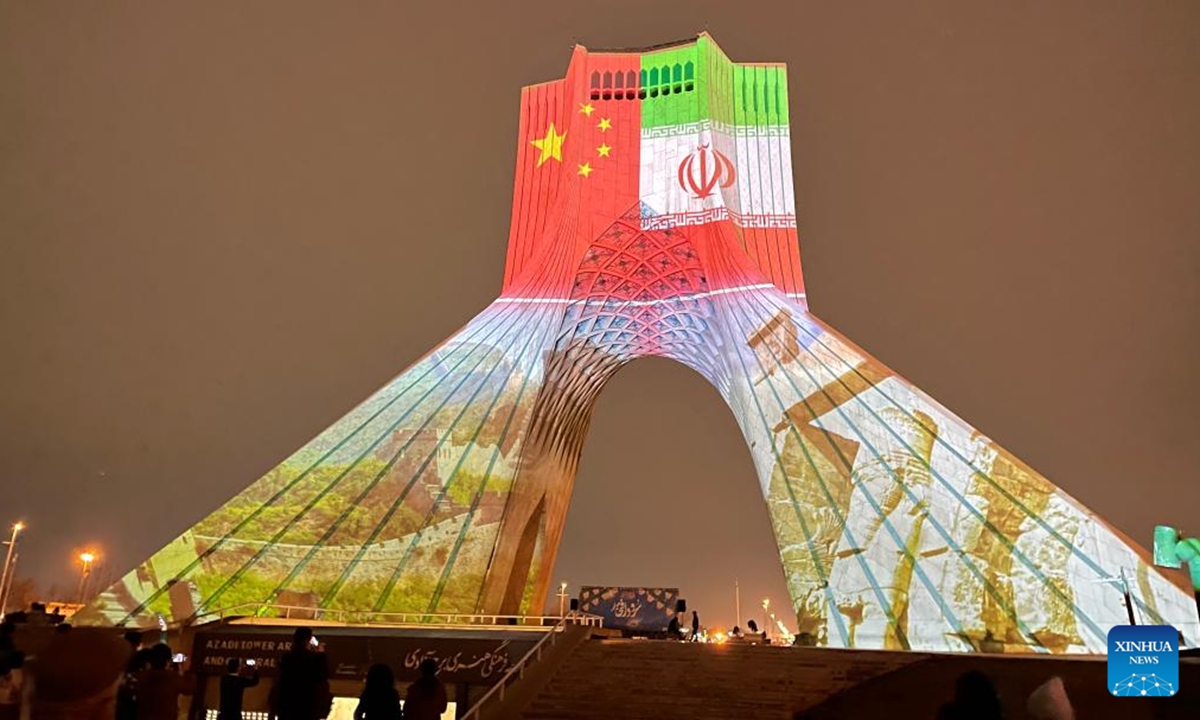
The Azadi Tower is illuminated to mark the Chinese Lunar New Year in Tehran, Iran, on Jan. 31, 2022. The iconic Azadi Tower in Tehran flashed red on Monday, a color associated with good luck and happiness in China, to mark the Chinese Lunar New Year, or Spring Festival, which falls on Feb. 1 this year. (Chinese Embassy in Iran/Handout via Xinhua)
At the invitation of Chinese President Xi Jinping, Iranian President Ebrahim Raisi will pay a state visit to China from February 14 to 16. This is a very important visit for both countries. The Iranian people expressed a lot of expectations for this trip, and Iran's state news agency IRNA followed up with relevant information as headline news. It is expected that China and Iran will sign many cooperative documents during President Raisi's China trip to continue deepening and expanding the comprehensive strategic partnership between the two countries.
In his meeting with President Raisi during the SCO Summit in Samarkand last year, President Xi mentioned that China views China-Iran relations from a strategic and long-term perspective. The Iranian government also said that this visit will have economic, political and strategic significance. "Strategic," as a high-frequency word throughout China-Iran cooperation, is a highly condensed expression of the connotation of the relationship between the two countries.
As two ancient civilizations in Asia, China and Iran are now important industrialized powers and energy producers respectively. The two countries are highly complementary economically, and both have a strong desire for development. The development needs of the two countries are highly compatible in many fields. For many years, China has been Iran's largest trading partner; Iran is one of the most important markets for China's overseas project contracting, and exports of complete sets of equipment and technology. Meanwhile, Iran is an important country in the process of China's high-quality development of the Belt and Road Initiative through joint efforts, and China is the target partner of Iran's "looking east"policy. The potential for future cooperation between the two sides is huge.
The development of China-Iran relations has a strong endogenous driving force. It can be said that President Raisi's visit to China is very natural. However, as Iran is still under severe sanctions by the US, and China is the main target of US' strategic suppression. With a narrow-minded mindset, some US and Western public opinion appeared rather odd in viewing the relationship between China and Iran, hyping that both China and Iran are "opposed" to the US and claiming that cooperation between the two sides will "weaken US efforts to isolate Iran." Such zero-sum thinking is arrogant, unreasonable and overbearing. China and Iran do not need to act according to their attitude, and it is even less likely that the two sides will reduce exchanges because some people are unhappy.
In fact, many of the achievements of China-Iran cooperation in recent years have been realized by overcoming interference and sabotage by the US side. It may be difficult to improve this situation in a short period of time, but outside the US-West bloc and its influence circle, there is huge space and potential for win-win cooperation between countries, including China and Iran, which cannot be blocked by the political forces of the US and the West.
In this sense, China's deepening cooperation with Iran also has anti-hegemony and anti-bullying feature. Both China and Iran uphold independent foreign policies, firmly defend the principle of non-interference in internal affairs on international occasions, and safeguard the common interests of developing countries. This is conducive to promoting the multi-polarization and diversified development of the world, and conforms to the general trend of the times. If anyone feels "targeted" in this process, then they should first reflect on whether they are too selfish.
The world today is undergoing major changes unseen in a century. Under Washington's moves, the international structure is being divided and restructured, with the vicious trend of forming blocs and camps again emerging, which puts the non-Western world in a difficult situation and once again faces historical choices. The existing US-led international system has designs to bully and exploit developing countries and emerging countries. Now Washington still thinks that it is not convenient enough, that the interests of developing countries have increased in weight, and wants to reconstruct a new international system with a stronger tendency, which is undoubtedly a major challenge for the non-Western world and needs to be resisted by forming a joint effort.
During the Cold War, many developing countries refused to join the bloc confrontation, and they started Non-Aligned Movement (NAM) to pursue independent, autonomic and non-camp purpose and principle. Today, two thirds of the UN members are members of the NAM and about 55 percent of the global population live in NAM countries. This is a mainstream political force deliberately ignored by the US and Western public opinion. China is a natural partner of the NAM, and it has always shared the destiny with vast number of developing countries, upheld correct concept of justice and interests and promoted global governance system in a fairer and reasonable direction.
Some US and Western media outlets viewed President Raisi's China visit as China and Iran "huddling together for warmth." Such view is not surprising to us, since it's a result of their binary opposition thinking, and also because Washington has distorted the international landscape. Through a distorted mirror, all things that the US and the West see are twisted. However, it must be said this underestimates China-Iran relations. As an old saying goes: How can a sparrow know the will of a swan? We welcome President Raisi's visit, and look forward to China-Iran relations reaching a new high.




